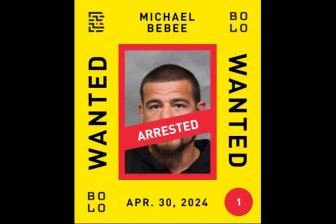An area of Chehalis, B.C., north of Harrison Mills, was once part of the habitat for the critically endangered spotted owl.

Now it has been logged.
“It was only approved for logging in June of this year by the B.C. provincial government, and they approved it months after the federal minister of environment had declared that forests like this are critical to the recovery of this highly endangered species spotted owl,” Joe Foy, a protected areas campaigner for the Wilderness Committee told Global News.
“So it’s a real shock to see it. It’s a real slap in the face for anyone who wants to see endangered species recover and I think most Canadians want that.”
The spotted owl is considered the most endangered bird in Canada.
There is just one spotted owl left in the wild, two additional owls released this year and then some in a breeding centre.
Overlogging of the owls’ habitat is the primary cause of their decline.

In March, the British Columbia government extended an old-growth logging ban for part of the Fraser Canyon for another two years to help with the recovery of the owl.
The province said deferring logging activity in two watersheds in the canyon is part of its plan to bring back a “sustained breeding population” of the owl.
The province extended the suspension of old-growth logging activity in the Spuzzum and Utzilus watersheds until February 2025.
Foy said the forest had been logged around the Second World War and had been growing for about 80 years.
“But at 80 years old, it’s not old enough to be habitat for this endangered species,” he said. “It’ll take another 40 years for this forest to attain that stature that it could support spotted owls. But it was on its way.
“So a beautiful forest, a hopeful forest — I think that’s one way to describe it, that there’s hope for the future.”
Foy added that now, the hope in this area has been crushed with a provincial permit handed out in June with the area now being logged.
“The province has obviously made a decision that they just wanted to do the minimum for this endangered species, that I should say other endangered species,” Foy said.
“B.C. is one of the few places in the country that has not enacted a species-at-risk law. We have to rely on the federal law, but there is no provincial law. There’s a reason for that. B.C. gives too much power to the logging industry, and it’s costing all of us. And it will cost our kids and our grandkids and our great-grandkids.”

Minister of Water, Land and Resource Stewardship Nathan Cullen told Global News Monday that the provincial government is dedicated to the spotted owl recovery in B.C.
“We’ve spent a lot of time, money and effort in that regards,” Cullen said. “We have, of course, (raised) spotted owls in captivity, first time in the world. That’s been done. We also set aside 280,000 hectares of old-growth habitat that we came to an agreement with the federal government and other interested parties some years ago.”
He explained that the current protection of old-growth forests allows for 150 breeding pairs of spotted owls to live in the wild successfully.
“There’s other areas that people do want protections on that they’ve declared as critical or important,” Cullen said. “But in terms of our work as (the) British Columbia government on behalf of B.C. and in bringing these owls back and introducing them back into the wild, we know that the habitat protections are more than sufficient to allow us to recover.”
Last week, the B.C. government announced $300 million in conservation financing in connection with the B.C. Parks Foundation and 80 First Nations to allow all groups to have a say in forestry decisions, Cullen added.
The province stated in an Oct. 26 release, between the forest industry and the province, deferrals have now been implemented on approximately 2.4 million hectares of old growth in B.C., including 1.23 million hectares of the most at-risk old growth identified by the Old Growth Technical Advisory Panel.
“So the larger 280,000 hectares that we’re protecting are protected,” Cullen said. “There’s no logging going on within that area and again, not a limitation to the owls being able to recover in the wild.”
Foy agreed that the captive breeding program is a very important part of saving the spotted owl, but they need proper habitat when they are released.
“And most importantly, that habitat needs to be connected. There needs to be corridors. And B.C. has not been willing to protect the forests necessary to do that. So it’s like building half a bridge. It doesn’t really work. They’ve done some good work. They’ve got to step up and do the rest.”
The spotted owls range from southwestern B.C. and into the United States.
“We still have in our region, throughout the province, these spectacular groves of old-growth forests,” Foy said. “So, suitable habitat for the spotted owl, but just incredibly beautiful spiritual places. And some of those places the province has designated as high priority for deferral. And this summer I’ve travelled to many of those places and I’ve seen many of those places being eroded and logged.
“The B.C. government says one thing and I see another thing happening out on the land. So it’s really important that all of us speak up again and again and say how much we don’t want species to go extinct and how much we really want to hand down a future with these magnificent old-growth forests which surround the Lower Mainland, but which are going down every day.”








Comments